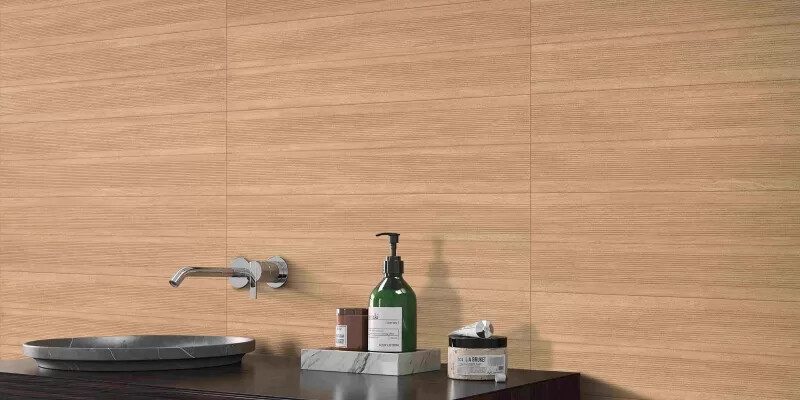Textured vs Full Body Tiles: Choosing the Right Style
Choosing the right tiles can influence the look, feel, and performance of your space. Textured tiles and full-body tiles are two popular options, each offering distinct advantages depending on where and how they are used. While textured tiles add visual depth and slip resistance, full-body tiles are known for their strength and uniform composition, making them ideal for high-traffic areas. Understanding the differences between the two can help you select a style that fits both your aesthetic preferences and practical needs.
Understanding Textured Tiles
A textured tile brings depth, grip, and visual richness to a surface. It features gentle patterns and raised detailing that can reflect natural elements such as stone, wood, or woven finishes, giving spaces a warm and organic feel.
These tiles work beautifully in areas where both design and functionality matter, such as bathrooms, balconies, kitchens, and outdoor patios. The added grip helps reduce slipperiness in wet or open spaces, while indoors, they can be used to create feature walls or statement flooring that adds tactile character. Their ability to interact with light and shadow makes textured tiles visually engaging, turning everyday surfaces into standout design elements while remaining easy to maintain.
The Strength of Full Body Tiles
Full body tiles are known for their strength and uniform composition. In these tiles, the colour and pattern continue through the entire thickness, from the surface to the core. This consistency makes them highly durable and resistant to chips and scratches.
Their solid build makes them suitable for spaces that experience frequent daily use, such as kitchens, hallways, offices, and various commercial interiors. Even if a corner gets slightly chipped, the appearance stays consistent because the design is present throughout the tile.
These tiles also offer a clean, refined look that works well in both contemporary and classic settings. Their durability, low maintenance requirements, and lasting visual appeal make them a practical and stylish choice for a wide range of spaces.
Design Appeal: Texture vs Uniformity
Textured tiles bring a handcrafted, organic feel to a space, while full-body tiles offer a more refined and consistent appearance. Textured surfaces add depth and warmth, making rooms feel expressive and inviting, while full-body vitrified tiles create a clean, modern backdrop. For instance, if the goal is a rustic or natural ambience, textured tiles with stone or wood-inspired detailing work beautifully.
For a minimalist setting, full-body tiles in soft neutrals create a calm, contemporary look. Brands like Simpolo Tiles & Bathware offer well-balanced options in both categories, focusing on realistic surface detailing and dependable quality, making it easier to choose tiles that align with your design vision without compromising performance.
Functionality and Maintenance
Textured tiles offer a good grip and add visual depth, making them suitable for areas exposed to moisture, such as balconies, bathrooms, and patios. The raised surface patterns may hold a bit of dust over time, so occasional brushing or light scrubbing helps maintain their fresh look.
Full body tiles have a dense, non-porous structure that naturally resists stains and makes everyday cleaning simple. Full body tiles work well in frequently used areas such as kitchens, corridors, and commercial interiors. Their sturdy construction also allows them to withstand weight and temperature changes, ensuring long-lasting performance with minimal upkeep.
Ideal Applications
To choose the right tile type, think about where you’re planning to use it:
- For Walls: Choose textured tiles to create visual interest. They add character and help accent or feature walls stand out without feeling too bold.
- For Floors: Full-body vitrified tiles are ideal, as they support movement and daily use while maintaining a consistent look over time.
- For Kitchens and Countertops: Full-body tiles are a practical pick since they resist stains and heat, making them suitable for cooking and prep areas.
- For Outdoor Areas: Textured tiles offer better grip and stability, helping prevent slips while keeping the space natural and inviting.
Style Combinations That Work
The most appealing designs come from thoughtful balance. You can use textured tiles to highlight specific areas, such as accent walls or backsplashes, while keeping the flooring clean and uniform with full-body tiles. This creates contrast without overwhelming the space.
Experimenting with tone variations also works beautifully. For example, pairing warm beige textured tiles on the walls with cool grey full-body tiles on the floor can subtly define different zones within the room. This approach adds depth, flow, and a refined sense of style to your interiors.
Conclusion
Both textured and full-body tiles offer valuable benefits that can enhance different areas of your home. Textured tiles contribute character, warmth, and slip resistance, making them suitable for spaces where visual depth and safety are important. Full-body tiles offer durability and a consistent appearance, making them well-suited for high-traffic areas and applications that require long-lasting performance.
The key is to consider how each space is used and choose tiles that support both the aesthetic and functional needs of the environment. With the right balance, your interiors can remain stylish, comfortable, and enduring over time.



